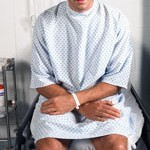- Phimosis, or preputial stenosis, is a term that usually means any condition where the foreskin of the penis cannot be retracted.
- Most infants are born with a foreskin that cannot be retracted and the prepuce may be tight until after puberty.
- A fully retractable foreskin occurs in 50% of ten year olds, 90% of 16 year olds and 98 to 99% of 18 year olds.
Causes of Phimosis
Phimosis can be caused by failure of foreskin to loosen during growth, infections such as balinitis, deformities caused by trauma and diseases of the genitals.
Symptoms of Phimosis
Phimosis is usually painless condition. Infection may result from an inability to carry out effective cleaning of the area in which case swelling, redness and discharge may all be present making the area tender and painful. A very tight foreskin can cause problems during intercourse, urination.
Paraphimosis
An inability to pull back the foreskin into position over the head of the penis can cause pain, swelling of the head of the penis and the foreskin. It may cause restricted blood flow, causing the head of the penis to become dark purple in color. If this should occur emergency treatment is required.
Deciding on treatment
Medical opinion differs on the condition and on treatment. It has been suggested that any radical or surgical treatments for phimosis should not be done until after puberty. This has partly come about because of the reaction to the over use of circumcision as a mainstream treatment for phimosis. It has also been reported by bodies such as CIRP that significant numbers of doctors are unable to recognise normal developmental tight prepuce and pathological phimosis. It is believed that many unnecessary circumcisions are performed because of current medical practice and misdiagnosis of phimosis. Balanitis xeroticia obliterans has been sited as one of the only causes of phimosis that should lead to a surgical circumcision.
Treatment of Phimosis
If treatment is required there are three main types:
- Tropical creams, steroidal and non steroidal, applied to the prepuce.
- Gradual stretching of the opening of the prepuce to widen it.
- Surgical reshaping of the prepuce to make it wider.
All these treatments tend to avoid the side effects associated with surgical circumcision, trauma, pain, side effects of removal of the foreskin such as friction and interference of the erogenous and sexual functions.
Treatment of Paraphimosis
If the foreskin cannot be pulled back into place treatment should be sought. If the blood flow to the penis is restricted then emergency treatment is required and if the foreskin cannot be pulled back a surgical cut to the trapped foreskin may be required. Failure to seek treatment can result in permanent damage to the penis.
Hygiene and the Foreskin
- The American Academy of Pediatics recommends that the immature foreskin of intact boys is not forced back for cleaning.
- The only person who should clean and retract the foreskin is the boy himself. Bubble bath products and other chemical irritants can cause the foreskin to tighten and it is recommended they should be avoided by intact males.






